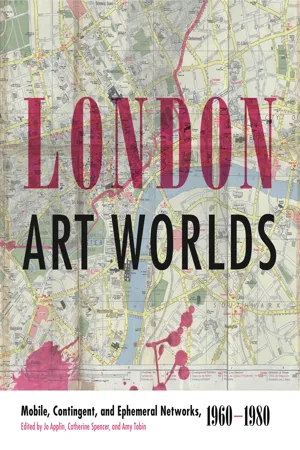
London Art Worlds
Mobile, Contingent, and Ephemeral Networks, 1960–1980
- English
- PDF
- Available on iOS & Android
London Art Worlds
Mobile, Contingent, and Ephemeral Networks, 1960–1980
About this book
The essays in this collection explore the extraordinarily rich networks of international artists and art practices that emerged in and around London during the 1960s and '70s, a period that saw an explosion of new media and fresh attitudes and approaches to making and thinking about art.
The contributors to London Art Worlds examine the many activities and movements that existed alongside more established institutions in this period, from the rise of cybernetics and the founding of alternative publications to the public protests and new pedagogical models in London's art schools. The essays explore how international artists and the rise of alternative venues, publications, and exhibitions, along with a growing mobilization of artists around political and cultural issues ranging from feminism to democracy, pushed the boundaries of the London art scene beyond the West End's familiar galleries and posed a radical challenge to established modes of making and understanding art.
Engaging, wide-ranging, and original, London Art Worlds provides a necessary perspective on the visual culture of the London art scene in the 1960s and '70s. Art historians and scholars of the era will find these essays especially valuable and thought provoking.
In addition to the editors, contributors to this volume are Elena Crippa, Antony Hudek, Dominic Johnson, Carmen Juliá, Courtney J. Martin, Lucy Reynolds, Joy Sleeman, Isobel Whitelegg, and Andrew Wilson.
Frequently asked questions
- Essential is ideal for learners and professionals who enjoy exploring a wide range of subjects. Access the Essential Library with 800,000+ trusted titles and best-sellers across business, personal growth, and the humanities. Includes unlimited reading time and Standard Read Aloud voice.
- Complete: Perfect for advanced learners and researchers needing full, unrestricted access. Unlock 1.4M+ books across hundreds of subjects, including academic and specialized titles. The Complete Plan also includes advanced features like Premium Read Aloud and Research Assistant.
Please note we cannot support devices running on iOS 13 and Android 7 or earlier. Learn more about using the app.
Information
Table of contents
- COVER front
- Copyright Page
- Table of Contents
- List of Illustrations
- Introduction
- Notes to Introduction
- Chapter 1: Everything Was Connected: Kinetic Art and Internationalism at Signals London, 1964–66
- Notes to Chapter 1
- Chapter 2: A Porous Entity: The Centre for Behavioural Art at Gallery House, 1972–73
- Notes to Chapter 2
- Chapter 3: Mapping the City: Felipe Ehrenberg in London, 1968–71
- Notes to Chapter 3
- Chapter 4: Restoring Some Period Color to Roelof Louw’s Pyramid of Oranges (1967)
- Notes to Chapter 4
- Chapter 5: Collectivity, Temporality, and Festival Culture in John Dugger’s Quasi-Architecture, 1970–74
- Notes to Chapter 5
- Chapter 6: Taking the Trouble to Sound It: Mediating Conflict in the Work of Rita Donagh
- Notes to Chapter 6
- Chapter 7: Circulations and Cooperations: Art, Feminism, and Film in 1960s and 1970s London
- Notes to Chapter 7
- Chapter 8: Project sigma: An Interpersonal Logbook
- Notes to Chapter 8
- Chapter 9: The Artist as a Speaker-Performer: The London Art School in the 1960s–70s
- Notes to Chapter 9
- Chapter 10: File Under COUM: Art on Trial in Genesis P-Orridge’s Mail Action
- Notes to Chapter 10
- Bibliography
- Contributors
- Index